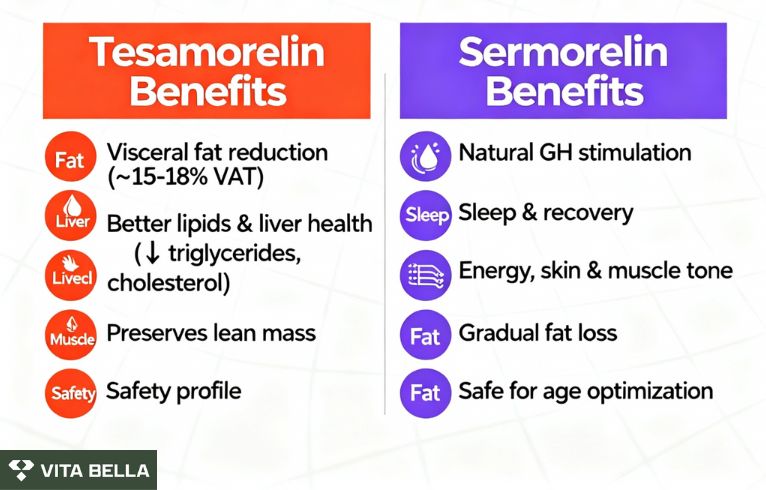From stubborn belly fat to age-related energy decline, peptide therapies are quickly emerging as science-backed solutions for fat loss, anti-aging, and long-term metabolic health.
Tesamorelin and Sermorelin are both growth-hormone-releasing peptide 1 (GHRP-1) analogues, but they serve different purposes and act with somewhat different intensities. Tesamorelin is a synthetic modified GHRH analogue clinically approved to reduce visceral adipose tissue (VAT), especially in HIV-associated lipodystrophy, with demonstrated drops in VAT of ~15-18% over 52 weeks.
Sermorelin, by contrast, is a shorter peptide fragment of GHRH (1-29) 2 that gently stimulates the pituitary to release human GH in more natural, pulsatile rhythms. While both peptides boost GH and downstream IGF-1, Tesamorelin tends to be more potent and fat-targeted. In contrast, Sermorelin is favored for long-term wellness 3, anti-aging, recovery, and more gradual improvements.
Don’t leave your wellness to chance. Whether it’s fat loss, recovery, or age optimization, our expert-guided therapies at Vita Bella help you achieve lasting results. Start your journey with us today.
The choice between them depends on goals, health status, and how aggressive intervention is desired.
What Are Growth Hormone Peptides?
Both Tesamorelin and Sermorelin act by mimicking growth hormone-releasing hormone (GHRH), binding to the GHRH receptors in the anterior pituitary and triggering the natural, pulsatile release of growth hormone (GH) 4 rather than supplying exogenous GH directly. Sermorelin (the GHRH-1-29 fragment) is especially valued in age management medicine because it restores GH secretion 5 patterns that typically decline over time.
Tesamorelin is a modified GHRH analogue engineered to have improved stability and pharmacokinetics, resulting in more sustained GH release compared to native GHRH 4. By acting upstream, both peptides allow a downstream increase in IGF-1 6, promote lipolysis (especially of visceral fat), and support metabolic health.
These peptides tend to carry a lower risk than direct HGH injections. Exogenous HGH can disrupt feedback loops, lead to supraphysiologic exposure, and increase risks (e.g., glucose intolerance, edema). By stimulating the body’s own GH production, Tesamorelin and Sermorelin maintain more physiological control and reduce those risks.
Key benefits of Tesamorelin:
Decrease Visceral Fat: In HIV-infected adults with abdominal fat accumulation, Tesamorelin treatment 7 led to about -15–18% reduction in visceral adipose tissue (VAT) over 26 to 52 weeks compared to placebo.
Improved Lipids & Liver Health: Alongside fat loss, there were significant drops in triglycerides and total cholesterol; liver fat decreased (~40%) in treatment groups while increasing in placebo arms during trials.
Preserved Lean Mass & Improved Fat Quality: Lean body mass was maintained, and evidence showed improved fat quality less intramuscular fat and increased fat density 8 in the truncal muscle groups.
Safety Profile & Side Effects: Generally well-tolerated 7. Mild glucose increases seen early in treatment resolved by 6 months; main side effects included injection-site reactions, some hypersensitivity or localized skin reactions, but serious adverse events were rare.
Key benefits of Sermorelin
Natural GH Stimulation via Pituitary: Sermorelin is a synthetic fragment of GHRH that stimulates pituitary 9 gene transcription and increases GH release in a physiological, pulsatile manner rather than forcing constant levels.
Enhanced Sleep & Recovery: Users often report better sleep quality and deeper rest; GH plays a major role in tissue repair and recovery during restorative sleep cycles.
Improved Energy, Skin, and Muscle Tone: With elevated GH/IGF-1, people may experience increased energy, improved skin elasticity, better muscle tone, and overall health.
Gradual Fat Loss (Less Targeted than Tesamorelin): Sermorelin supports gentle fat loss (including visceral fat) over time, though not as specific or fast-acting as Tesamorelin in clinical trials.
Generally Safer & Broadly Used for Age Optimization: Because Sermorelin works by encouraging existing GH production rather than bypassing upstream control, it tends to have fewer risks and side effects compared to GH injections.
What to choose from Tesamorelin and Sermorelin
Choosing between Tesamorelin and Sermorelin depends on your health goals. Tesamorelin is FDA-approved for reducing visceral adipose tissue (VAT) 4 in HIV-associated lipodystrophy, achieving ~15–18% VAT reduction in clinical trials, with added benefits for liver and lipid health. In contrast, Sermorelin stimulates natural GH release 10, improving sleep, recovery, and age-related GH decline with gradual fat loss and fewer metabolic risks. Tesamorelin is best for targeted fat reduction, while Sermorelin is suited for broader age optimization.
Take the Next Step Toward Better Health
Visceral fat and low growth hormone levels resist traditional approaches. At Vita Bella, we offer personalized Tesamorelin and Sermorelin therapies that target the root causes, helping you achieve fat loss, improved recovery, and renewed energy.

FAQs
1. What’s the main difference between Tesamorelin and Sermorelin?
Tesamorelin is FDA-approved and targets explicitly visceral fat reduction (~15–18% in studies), while Sermorelin is more commonly used for anti-aging, sleep, and recovery benefits through natural GH stimulation.
2. Is Sermorelin safer than Tesamorelin?
Both peptides are considered safe, but Sermorelin is often preferred for age optimization due to its physiological, pulsatile GH release and generally lower risk profile. Tesamorelin is well-tolerated but may cause mild injection-site reactions or temporary glucose changes.
3. Who should consider Tesamorelin over Sermorelin?
Tesamorelin is more suitable for individuals struggling with excess visceral fat, especially in HIV-associated lipodystrophy or metabolic risk, while Sermorelin is better for those seeking gradual improvements in energy, recovery, and overall wellness.
References:
ScienceDirect. (n.d.). Sermorelin – an overview. In Pharmacology, Toxicology, and Pharmaceutical Science. Retrieved from https://www.sciencedirect.com/topics/pharmacology-toxicology-and-pharmaceutical-science/sermorelin
National Institute of Diabetes and Digestive and Kidney Diseases. (2018, October 20). Tesamorelin. In LiverTox: Clinical and Research Information on Drug-Induced Liver Injury. Bethesda, MD: National Library of Medicine. https://www.ncbi.nlm.nih.gov/books/NBK548730/





















